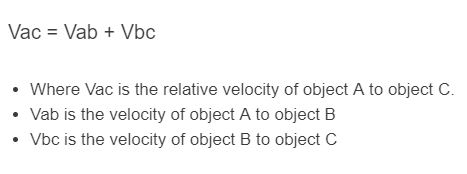Enter the velocity of an object A to an object B, and the velocity of an object B to an object C to determine the relative velocity of A to C.
- All Velocity Calculators
- Velocity Calculator
- Initial Velocity Calculator
- Instantaneous Velocity Calculator
- Relativistic Velocity Calculator
- Relative Force Calculator
- True Velocity Calculator
- Separation Velocity Calculator
- Time Dilation Calculator
Relative Velocity Formula
The following formula is used to calculate a relative velocity.
Vac = Vab + Vbc
- Where Vac is the relative velocity of object A to object C.
- Vab is the velocity of object A to object B
- Vbc is the velocity of object B to object C
To calculate a relative velocity from point A to C, sum the velocities from point A to B and from B to C.
Relative Velocity Definition
A relative velocity is defined as the velocity of an object in reference to the speed of another object.
Relative Velocity Example
How to calculate a relative velocity?
- Fist, determine the velocity of A to B.
Calculate the velocity of A to B.
- Next, determine the velocity of B to C.
Measure the velocity of B to C.
- Finally, calculate the velocity of A to C.
Calculate the velocity of A relative to C using the equation above.
FAQ
A relative velocity is the velocity of an object when in the reference frame of another object. For example, say object A is moving at 10m/s to the ground but object B is moving at 5m/s when compare to the ground. The relative velocity of A to B would be 5m/s to 10m/s.

